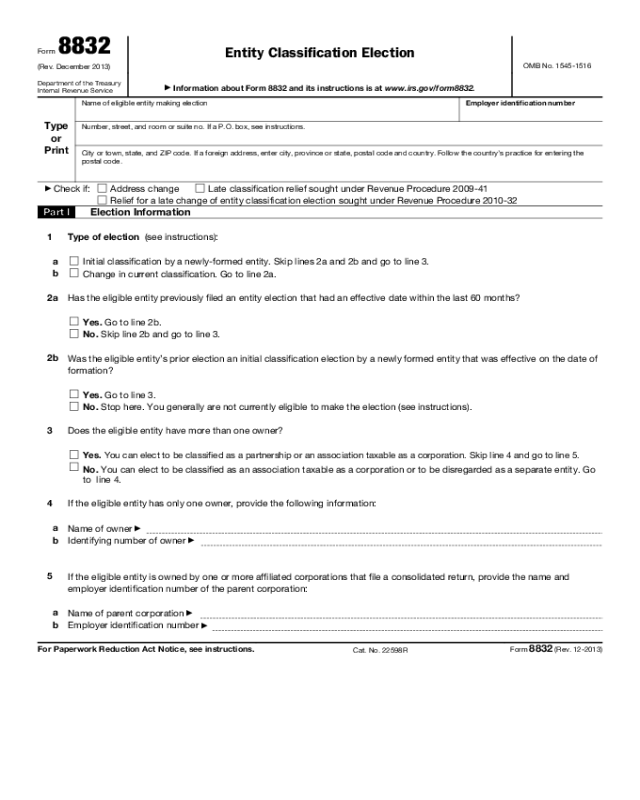
Form 8832 (Rev. 12-2013)
Page 6
Specific Instructions
Name. Enter the name of the eligible entity
electing to be classified.
Employer identification number (EIN). Show
the EIN of the eligible entity electing to be
classified.
▲
!
CAUTION
Do not put “Applied For” on
this line.
Note. Any entity that has an EIN will retain
that EIN even if its federal tax classification
changes under Regulations section
301.7701-3.
If a disregarded entity’s classification
changes so that it becomes recognized as a
partnership or association for federal tax
purposes, and that entity had an EIN, then the
entity must continue to use that EIN. If the
entity did not already have its own EIN, then
the entity must apply for an EIN and not use
the identifying number of the single owner.
A foreign entity that makes an election
under Regulations section 301.7701-3(c) and
(d) must also use its own taxpayer identifying
number. See sections 6721 through 6724 for
penalties that may apply for failure to supply
taxpayer identifying numbers.
If the entity electing to be classified using
Form 8832 does not have an EIN, it must
apply for one on Form SS-4, Application for
Employer Identification Number. The entity
must have received an EIN by the time Form
8832 is filed in order for the form to be
processed. An election will not be accepted if
the eligible entity does not provide an EIN.
▲
!
CAUTION
Do not apply for a new EIN for an
existing entity that is changing its
classification if the entity already
has an EIN.
Address. Enter the address of the entity
electing a classification. All correspondence
regarding the acceptance or nonacceptance
of the election will be sent to this address.
Include the suite, room, or other unit number
after the street address. If the Post Office
does not deliver mail to the street address
and the entity has a P.O. box, show the box
number instead of the street address. If the
electing entity receives its mail in care of a
third party (such as an accountant or an
attorney), enter on the street address line
“C/O” followed by the third party’s name and
street address or P.O. box.
Address change. If the eligible entity has
changed its address since filing Form SS-4 or
the entity’s most recently-filed return
(including a change to an “in care of”
address), check the box for an address
change.
Late-classification relief sought under
Revenue Procedure 2009-41. Check the box
if the entity is seeking relief under Rev. Proc.
2009-41, 2009-39 I.R.B. 439, for a late
classification election. For more information,
see Late Election Relief, later.
Relief for a late change of entity
classification election sought under
Revenue Procedure 2010-32. Check the box
if the entity is seeking relief under Rev. Proc.
2010-32, 2010-36 I.R.B. 320. For more
information, see Foreign default rule, earlier.
Part I. Election Information
Complete Part I whether or not the entity is
seeking relief under Rev. Proc. 2009-41 or
Rev. Proc. 2010-32.
Line 1. Check box 1a if the entity is choosing
a classification for the first time (i.e., the entity
does not want to be classified under the
applicable default classification). Do not file
this form if the entity wants to be classified
under the default rules.
Check box 1b if the entity is changing its
current classification.
Lines 2a and 2b. 60-month limitation rule.
Once an eligible entity makes an election to
change its classification, the entity generally
cannot change its classification by election
again during the 60 months after the effective
date of the election. However, the IRS may
(by private letter ruling) permit the entity to
change its classification by election within the
60-month period if more than 50% of the
ownership interests in the entity, as of the
effective date of the election, are owned by
persons that did not own any interests in the
entity on the effective date or the filing date of
the entity’s prior election.
Note. The 60-month limitation does not apply
if the previous election was made by a newly
formed eligible entity and was effective on the
date of formation.
Line 4. If an eligible entity has only one
owner, provide the name of its owner on line
4a and the owner’s identifying number (social
security number, or individual taxpayer
identification number, or EIN) on line 4b. If the
electing eligible entity is owned by an entity
that is a disregarded entity or by an entity that
is a member of a series of tiered disregarded
entities, identify the first entity (the entity
closest to the electing eligible entity) that is
not a disregarded entity. For example, if the
electing eligible entity is owned by
disregarded entity A, which is owned by
another disregarded entity B, and disregarded
entity B is owned by partnership C, provide
the name and EIN of partnership C as the
owner of the electing eligible entity. If the
owner is a foreign person or entity and does
not have a U.S. identifying number, enter
“none” on line 4b.
Line 5. If the eligible entity is owned by one or
more members of an affiliated group of
corporations that file a consolidated return,
provide the name and EIN of the parent
corporation.
Line 6. Check the appropriate box if you are
changing a current classification (no matter
how achieved), or are electing out of a default
classification. Do not file this form if you fall
within a default classification that is the
desired classification for the new entity.
Line 7. If the entity making the election is
created or organized in a foreign jurisdiction,
enter the name of the foreign country in which
it is organized. This information must be
provided even if the entity is also organized
under domestic law.
Line 8. Generally, the election will take effect
on the date you enter on line 8 of this form,
or on the date filed if no date is entered on
line 8. An election specifying an entity’s
classification for federal tax purposes can
take effect no more than 75 days prior to the
date the election is filed, nor can it take effect
later than 12 months after the date on which
the election is filed. If line 8 shows a date
more than 75 days prior to the date on which
the election is filed, the election will default to
75 days before the date it is filed. If line 8
shows an effective date more than 12 months
from the filing date, the election will take
effect 12 months after the date the election is
filed.
Consent statement and signature(s). Form
8832 must be signed by:
1. Each member of the electing entity who
is an owner at the time the election is filed; or
2. Any officer, manager, or member of the
electing entity who is authorized (under local
law or the organizational documents) to make
the election. The elector represents to having
such authorization under penalties of perjury.
If an election is to be effective for any
period prior to the time it is filed, each person
who was an owner between the date the
election is to be effective and the date the
election is filed, and who is not an owner at
the time the election is filed, must sign.
If you need a continuation sheet or use a
separate consent statement, attach it to
Form 8832. The separate consent statement
must contain the same information as shown
on Form 8832.
Note. Do not sign the copy that is attached to
your tax return.
Part II. Late Election Relief
Complete Part II only if the entity is requesting
late election relief under Rev. Proc. 2009-41.
An eligible entity may be eligible for late
election relief under Rev. Proc. 2009-41,
2009-39 I.R.B. 439, if each of the following
requirements is met.
1. The entity failed to obtain its requested
classification as of the date of its formation (or
upon the entity's classification becoming
relevant) or failed to obtain its requested
change in classification solely because Form
8832 was not filed timely.
2. Either:
a. The entity has not filed a federal tax or
information return for the first year in which
the election was intended because the due
date has not passed for that year's federal tax
or information return; or
b. The entity has timely filed all required
federal tax returns and information returns (or
if not timely, within 6 months after its due
date, excluding extensions) consistent with its
requested classification for all of the years the
entity intended the requested election to be
effective and no inconsistent tax or
information returns have been filed by or with
respect to the entity during any of the tax
years. If the eligible entity is not required to
file a federal tax return or information return,
each affected person who is required to file a
federal tax return or information return must
have timely filed all such returns (or if not
timely, within 6 months after its due date,
excluding extensions) consistent with the











